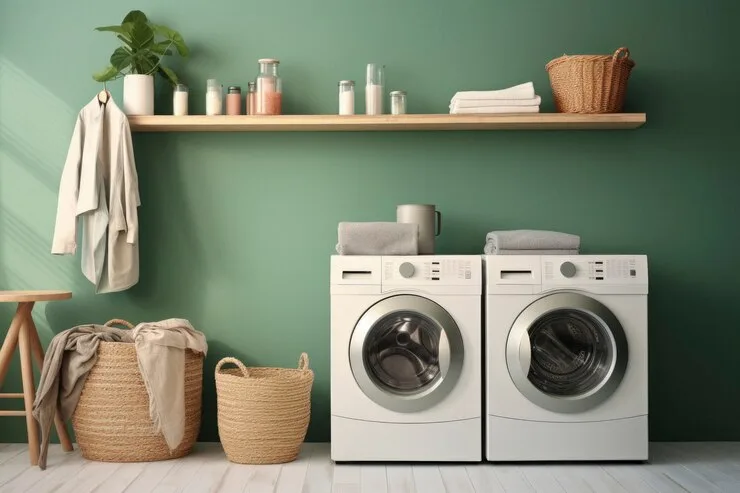Your laundry room might be secretly working against you. Even if you’ve invested in an energy-efficient washer and dryer, there are still hidden factors that could be wasting power, increasing water usage, and driving up your utility bills.
Luckily, most of these issues are easy to fix once you know what to look for. Here are some of the biggest energy wasters lurking in your laundry room—and what you can do about them.
1. Poor Washer & Dryer Installation
Let’s start with the basics. If your washer and dryer weren’t set up properly, you might be losing efficiency without even realizing it.
- Incorrect leveling: A washer that isn’t level has to work harder, leading to longer cycles and higher energy use.
- Improper venting: A clogged or poorly installed dryer vent restricts airflow, forcing the dryer to run longer and use more electricity.
- Water supply inefficiencies: If your washer isn’t connected correctly, it may use more water than necessary, leading to waste.
The Fix: Professional installation services from a reputable company like Travis County Appliance Repair ensures everything is set up correctly to maximize efficiency from day one. It’s a small investment that can lead to long-term savings on your utility bills.
2. Overloading or Underloading Your Washer and Dryer
It might seem like cramming more clothes into the washer saves water and energy, but that’s not how it works. Overloading prevents proper agitation, meaning clothes come out less clean and require another wash. It also forces your dryer to work harder, extending drying times.
On the flip side, running small loads wastes water and energy because your machine still goes through a full cycle.
The Fix: Stick to the manufacturer’s recommended load size. As a general rule, fill your washer about ¾ of the way to balance efficiency and cleanliness. For the dryer, avoid stuffing it full—clothes need room to tumble and dry evenly.
3. Using the Wrong Water Temperature
Hot water isn’t always necessary. In fact, about 90% of the energy used for washing clothes goes toward heating the water. Unless you’re washing heavily soiled items, warm or cold water is usually enough to get the job done.
The Fix: Switch to cold water for most loads. Many modern detergents are designed to work well in cold water, so you won’t sacrifice cleanliness. If you need warm or hot water for certain fabrics, use it sparingly.
4. Letting Lint Build Up in the Dryer Vent
A clogged dryer vent does more than increase fire risk—it also makes your dryer work harder. Poor airflow means longer drying times and higher energy use. If you’ve noticed that your clothes aren’t drying as quickly as they used to, lint buildup might be the culprit.
The Fix: Clean the lint trap after every load and check your dryer vent regularly. A thorough cleaning every six months keeps things running efficiently. If you’re unsure how to clean the vent properly, consider hiring a professional.
5. Ignoring the High-Spin Cycle
If your washer has a high-spin option, use it! This setting removes more moisture from your clothes before they hit the dryer, meaning they’ll dry faster and use less energy. Many people skip this step, assuming it doesn’t make a big difference—but it does.
The Fix: Use the highest spin speed that your fabrics can handle. Delicates might require a lower setting, but for towels, jeans, and other sturdy fabrics, high spin is your friend.
6. Running Loads at Peak Energy Hours
Your laundry habits might be costing you more than you think. Many utility companies charge higher rates during peak hours (typically late afternoon and early evening). Running your washer and dryer at these times could be inflating your electricity bill.
The Fix: Check with your utility provider to see if they offer lower rates during off-peak hours. If they do, try running your laundry in the early morning or late at night to save money.
7. Keeping an Outdated Washer & Dryer
If your washer and dryer are more than 10-15 years old, they could be guzzling energy compared to newer models. Older machines use significantly more water and electricity, even if they still get the job done.
The Fix: If you’re due for an upgrade, look for ENERGY STAR®-certified appliances. These machines use less energy and water while delivering better results. If replacing your appliances isn’t in the budget yet, at least make sure your current ones are properly maintained to keep them running efficiently.
8. Using Too Much Detergent
It’s easy to assume that more detergent equals cleaner clothes, but that’s not the case. Excess detergent creates extra suds, making your washer work harder to rinse everything out. In high-efficiency machines, using too much soap can even leave a residue that traps dirt and bacteria.
The Fix: Follow the detergent guidelines for your washer. If you have a high-efficiency machine, you only need a small amount of detergent to get clean clothes. Stick to the recommended dosage and consider using concentrated formulas.
9. Letting Clothes Sit in the Dryer
Many people forget to remove clothes from the dryer right away, leaving them to sit in a warm drum. This often leads to wrinkles, which means you’ll need to run another cycle or spend extra time ironing—both of which waste energy.
The Fix: Set a timer to remind yourself when your dryer cycle is finished. If you’re worried about wrinkles but can’t remove the clothes right away, use the wrinkle-release setting instead of running another full cycle.
10. Not Utilizing Dryer Balls
Dryer sheets might smell nice, but they don’t help your machine run more efficiently. In contrast, wool dryer balls speed up drying time by separating clothes and improving airflow. They also reduce static and soften fabrics without the need for chemicals.
The Fix: Swap out dryer sheets for reusable wool dryer balls. They can cut drying time by 25-30%, which adds up to significant energy savings over time.
Spin Smarter, Save More
Laundry is a never-ending chore, but that doesn’t mean it has to be an energy drain. By making a few simple adjustments, you can reduce waste, lower your energy bills, and extend the life of your appliances. Because when your laundry room runs efficiently, everything else in your home does, too.

